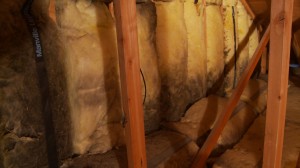Mold requires moisture, above-freezing temperatures, oxygen, and nutrients to grow. The nutrients can come from many building materials such as the paper facing on drywall or wood. Mold spores enter a home through open windows and doors, on the clothing and shoes of people, or in the fur of a pet. As mold spores are assumed to be present in most environments, they easily can enter a home. If spores land on a surface with available nutrients and moisture, they can grow into a colony.
Preventing mold growth usually is focused on controlling moisture, since above-freezing temperatures and oxygen also are required by the house’s human occupants. In homes, water leaks and condensation are the primary sources of moisture that lead to most mold growth. Examples of water leaks would be a break in the building envelope, such as a hole in the roof that allows rain to enter, or a plumbing leak. Condensation occurs when humid air encounters a cool surface, such as the windows in an exterior wall. When air containing water vapor cools to the dew point, it can no longer hold as much moisture and that excess moisture is then deposited on the adjacent cool surface in the form of water droplets. Air with high humidity is common in bathrooms and kitchens because cooking and showering expose the surrounding air to substantial amounts of water. However, plants, aquariums and even breathing contribute to the humidity level in a home.
Preventing mold growth
Keeping indoor humidity levels low is a big step towards preventing mold growth. Although indoor humidity that ranges between 40 and 60 percent at room temperature is best for human health, the reality is that in an extreme cold climate with temperatures below -20°F (such as Fairbanks), levels of more than 30 percent can lead to condensation forming on cooler surfaces such as windows, exterior walls behind furniture, and in closets. Indoor humidity levels between 20 and 30 percent are much safer in terms reducing the condensation risk during winters in Fairbanks, especially during very cold periods. However, this will vary depending on the insulation level of your home. Humidity levels lower than 30 percent can be tolerated by humans, however a greater percentage of occupants may experience the physical discomforts associated with drier air. To measure the humidity level in your home, you can buy a hygrometer at a hardware store or online for between $20 and $60. To prevent humidity from reaching damaging levels and maintain healthy indoor air quality, tight houses will require ventilation systems, such as exhaust fans in bathrooms and kitchens or a whole-house Heat Recovery Ventilator (HRV).
Even homes with a low overall humidity may have damp microclimates where mold can grow. Inspect areas such as crawlspaces periodically. A crawl space can produce large quantities of water vapor if damp soils aren’t covered with an intact and well sealed vapor retarder. In the crawlspace be on the lookout for water leaks, air leaks in ducts, or condensation on pipes, concrete or discolorations on wood surfaces — particularly around the rim joist area. Be sure to address any issues promptly. If there is standing water as a result of a leak, you have 24-48 hours to dry the area before mold spores can settle in and grow, so clean up the water as soon as you can, and then use a dehumidifier or fan to help dry out the area.
Damp areas on walls can be eliminated by making sure there is air an air space and good circulation between the wall and any furniture, clothing, or other objects. Firewood drying indoors also can contribute to moisture loads. A plugged or disconnected dryer vent can introduce large amounts of water vapor into the air and go unnoticed. Inspect all vents to the exterior periodically to ensure they are in good working order. Eliminate any standing water in the home. You can prevent standing water in showers and sinks by keeping drains clear and clean. Keeping a pot or kettle full of water going on the stove should be avoided.
Finally, if you do discover mold growth, it is important to clean it up as soon as possible to stop the mold from spreading and to prevent further occupant exposure.
